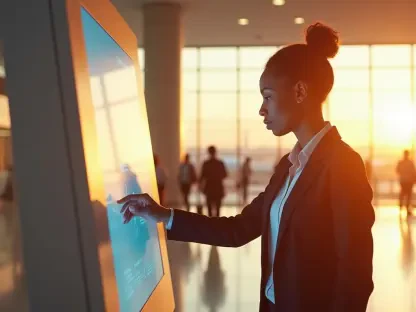The retail industry is undergoing a seismic shift, propelled by the rapid advancements in computer vision technology. This specialized field within artificial intelligence (AI) empowers machines to interpret, analyze, and make decisions based on visual datasets. The implementation of computer vision in retail is radically transforming traditional operations and significantly improving customer experiences, offering a plethora of benefits that are revolutionizing the sector. Retailers are leveraging this transformative tech to streamline processes, enhance consumer interaction, and optimize inventory management, thereby heralding a new era of retail innovation.
Frictionless Shopping Experience
The common aim for both retailers and consumers is to achieve a seamless shopping experience. Traditional checkout systems often involve long queues, manual scanning, and occasional errors caused by human activity. These inefficiencies are addressed by computer vision through the enablement of automated, cashierless stores. A prime example is Amazon Go, which integrates computer vision, sensor fusion, and deep learning algorithms to design a ‘Just Walk Out’ shopping experience. Cameras equipped with edge computing solutions capture customers’ actions, ensuring that items removed from shelves are instantly billed to their Amazon account upon exit. This frictionless experience eliminates delays and significantly enhances customer convenience, setting a new benchmark in retail that prioritizes speed and accuracy over traditional methods.
The focus on providing a rapid and error-free shopping journey is also reflected in the reduction of manual labor required at checkout points. This results in a more streamlined process, reducing the likelihood of errors and freeing up staff to focus on other aspects of store operations. Additionally, the data gathered from these automated systems can be used to gain insights into customer behavior, helping retailers to better understand purchasing patterns and preferences. These insights can then be utilized to improve store layouts and optimize product placements, further enhancing the shopping experience and driving sales.
Autonomous Inventory Management
Retail inventory management is known for being labor-intensive and prone to errors, but computer vision technology offers a promising solution through real-time automated tracking. Smart cameras are introduced to continuously scan retail spaces, immediately flagging items that are out of stock or misplaced. For instance, some major retailers deploy shelf-scanning robots that navigate the store aisles to identify inventory gaps in real time. A notable example is Schnuck Markets, whose 2021 project showcased that robots could detect out-of-stock items more effectively than hand scans, significantly enhancing customer satisfaction by ensuring constant product availability. Beyond stock tracking, computer vision plays a crucial role in quality control by identifying damaged or expired products, thereby reducing risks of customer dissatisfaction and potential liabilities.
By analyzing both historical and real-time customer behavior data, retailers are now able to forecast product demand with much greater accuracy. This capability leads to smarter procurement strategies, reducing instances of overstock and stockouts. In franchise operations, computer vision aids in optimal routing of pallets from local warehouses, integrating eco-friendly practices to minimize carbon emissions. The efficiency and accuracy brought by computer vision in managing inventory foster a more reliable and responsive supply chain.
Streamlined Store Operations
The reduction in the need for extensive human staffing in various retail operations is one of the significant impacts of computer vision. This technology extends beyond inventory management, positively influencing broader store management practices. Key aspects of this transformation include optimizing the customer journey within physical spaces through the use of retail heat map analytics and more effective queue management systems. Retailers such as Tesco utilize heat maps derived from real-time data on customer movement to tailor store layouts, thereby improving the overall shopping experience. In addition, computer vision assists in automating staff tasks, tackling store upkeep activities such as floor cleaning and temperature monitoring autonomously.
With the post-pandemic era driving the need for stringent occupancy monitoring, computer vision-enabled cameras have become instrumental in counting customers in real-time at store entrances and exits. This real-time monitoring ensures compliance with occupancy regulations, adding an extra layer of operational safety and enhancing customer trust. Furthermore, the automation of mundane tasks allows staff to focus on customer service, thereby enhancing the overall shopping experience. By streamlining store operations through computer vision, retailers can achieve higher operational efficiency and provide a more enjoyable shopping environment for customers.
Loss Prevention and Security
Traditional brick-and-mortar stores face ongoing challenges with theft and fraud, but computer vision technology is providing store security with powerful new tools. Integration of machine learning with visual data allows for enhanced monitoring, analysis, and even prediction of suspicious behaviors. A leading example is Walmart, where computer vision cameras are employed to identify shoplifting and other suspicious patterns, such as customers lingering without making a purchase. These AI systems continuously learn and improve over time, reducing the rate of false positives and minimizing wrongful customer accusations, thereby enhancing overall store security and customer trust.
The use of computer vision for loss prevention extends to more than just detecting shoplifting. It can also be applied to monitor employee behavior, ensure compliance with store policies, and detect any unusual activities that could indicate internal theft. As these systems evolve, they will become even more accurate and reliable, offering a robust solution for retail security. The advantage of computer vision in loss prevention lies in its ability to provide continuous, real-time monitoring, allowing retailers to respond to potential issues immediately and proactively.
Virtual Try-On Experiences with Augmented Reality (AR)
Computer vision combined with augmented reality (AR) is revolutionizing the shopping experience, especially in sectors like fashion, cosmetics, and eyewear. Retailers are leveraging these technologies to offer virtual try-ons, reducing decision-making friction for consumers and enhancing overall satisfaction. For instance, Warby Parker employs computer vision and AR to allow users to virtually try on eyeglass frames, giving them a realistic view of how the frames will look on their face. Similarly, L’Oréal has implemented AR makeup experiences that enable customers to virtually apply products, significantly boosting engagement and conversion rates. These technologies not only improve the accuracy of online shopping decisions but also reduce return rates and the associated costs.
The introduction of virtual try-on experiences has dramatically transformed the retail landscape by providing customers with a more interactive and engaging shopping experience. These technologies help bridge the gap between online and in-store shopping by offering a personalized and convenient way to try products before making a purchase. This, in turn, reduces the uncertainty and guesswork often associated with online shopping, leading to higher customer satisfaction and loyalty.
Personalized In-Store Marketing
The retail industry is experiencing a significant transformation driven by rapid advancements in computer vision technology. This specialized area within artificial intelligence (AI) enables machines to understand, analyze, and make decisions based on visual data. As computer vision becomes increasingly integrated into retail, it is reshaping traditional operations and greatly enhancing customer experiences. The technology offers numerous benefits that are revolutionizing the industry, making processes more efficient and interactions more personalized.
Retailers are adopting this cutting-edge technology to streamline various processes, from checkout systems to inventory management. For instance, computer vision can enable automated checkouts, reducing wait times and improving overall customer satisfaction. Additionally, retailers can use this technology to better track and manage inventory, ensuring that popular items are always in stock and reducing instances of overstock.
Moreover, computer vision enhances consumer interaction by offering personalized shopping experiences. For example, in-store cameras equipped with this technology can analyze customer behavior, helping retailers understand preferences and tailor promotions accordingly. This not only boosts sales but also fosters customer loyalty.
Overall, the implementation of computer vision in retail marks the dawn of a new era. By optimizing inventory and elevating customer interaction, this technology is setting new standards in the industry, driving innovation, and making the retail experience smoother and more enjoyable.









